The pursuit of longevity and the quest for immortality are not new phenomenons. Humans have looked for ways to extend their lifespan since the dawn of time.
These days, most of us have accepted the fact that our place on earth is temporary and that we’ll likely vanish before our 100th birthday — and maybe much sooner.
We’ve even come to accept that we likely won’t die of “old age,” but a disease that is often preventable. I’m referring to metabolic diseases, such as cancer, heart disease, diabetes, Alzheimer’s and all the other ailments we inflict on ourselves with the lifestyle choices we make.
As a result, some people don’t even want to entertain the thought of living longer, since it might mean living another 10 years with a disease that reduces their quality of life (and that might cost a fortune to treat).
Ever since I started taking care of my body by embracing an animal-based diet, practicing intermittent fasting, doing CrossFit and keeping a strict sleep regimen, my goal has been to stay healthy for as long as possible, regardless of how long I live.
A few months ago, I read a book about the science of aging that explains what happens in the body as we get older, and what we can do to slow down or even reverse that process.
Reading about the latest scientific discoveries in the field of anti-aging got me excited, and I now believe that adding a few healthy decades to my lifespan (barring any accidents) is within the realm of possibilities.
Note that some of the methods outlined in this article require the help of a knowledgeable medical professional who specializes in anti-aging. I’m working with Dr. Randy Smith of Anti-Aging Atlanta. You can reach out to him via email and tell him that you read my article and are interested in a free consultation.
In this article, I’ll share the latest scientific discoveries I’ve learned about, and explain what steps I take to try and slow down aging.
What Happens to Our Body as We Age
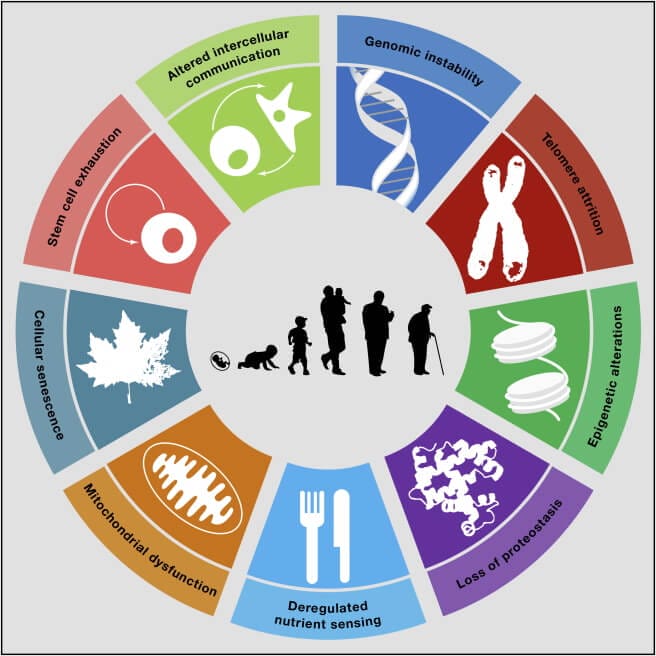
I always thought that aging was characterized by a slowdown of the body’s metabolic processes. For example, cells would stop dividing and not make new ones.
In reality, the aging process is a little more complicated than I realized. So let me give you an overview of the scientifically-accepted hallmarks of aging before we dive into how to influence them with lifestyle choices, supplements and medication.
In a nutshell, the process of aging is marked by the following factors (don’t worry if these terms don’t mean anything to you, as I’ll explain each one below):
- Altered intercellular communication
- Cellular senescence
- Deregulated nutrient sensing
- Epigenetic alterations
- Genome instability (DNA)
- Loss of proteostasis
- Mitochondrial dysfunction
- Stem cell exhaustion
- Telomere attrition
Altered Intercellular Communication
Cells constantly communicate with each other via messenger chemicals, and a breakdown in communication prevents the affected cells from working optimally. Some of the consequences of impaired cellular communication (as far as aging is concerned) include inflammation, hormonal imbalances in the brain and an impaired immune system.
Cellular Senescence
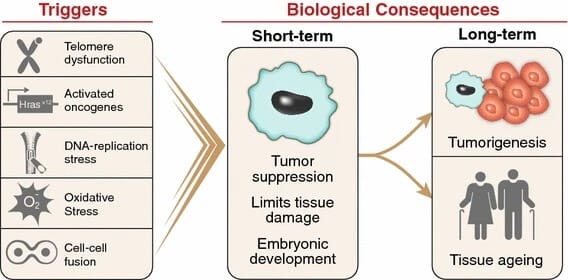
In young organisms, cellular senescence (the inability of cells to divide) is important for preventing the proliferation of damaged cells and the occurrence of cancer.
As we age, those senescent cells tend to pile up because the body becomes less capable of cleaning them up and replenishing them with new ones. That phenomenon is what many people associate with aging, and what I thought was the primary cause of it.
To illustrate the problem, think about maintaining a brick wall. The bricks in your wall deteriorate over time. When you see a bad brick, you replace it with a good one.
You can do that for as long as you have a steady supply of new bricks. But once that supply runs out, you can’t properly maintain the wall anymore, which will cause it to deteriorate even further.
In a sense, aging causes our bodies to run out of good bricks (cells). This is, of course, an extremely simplified analogy. In reality, the impact of cellular senescence on tissue growth and repair is much more complex.
Deregulated Nutrient Sensing
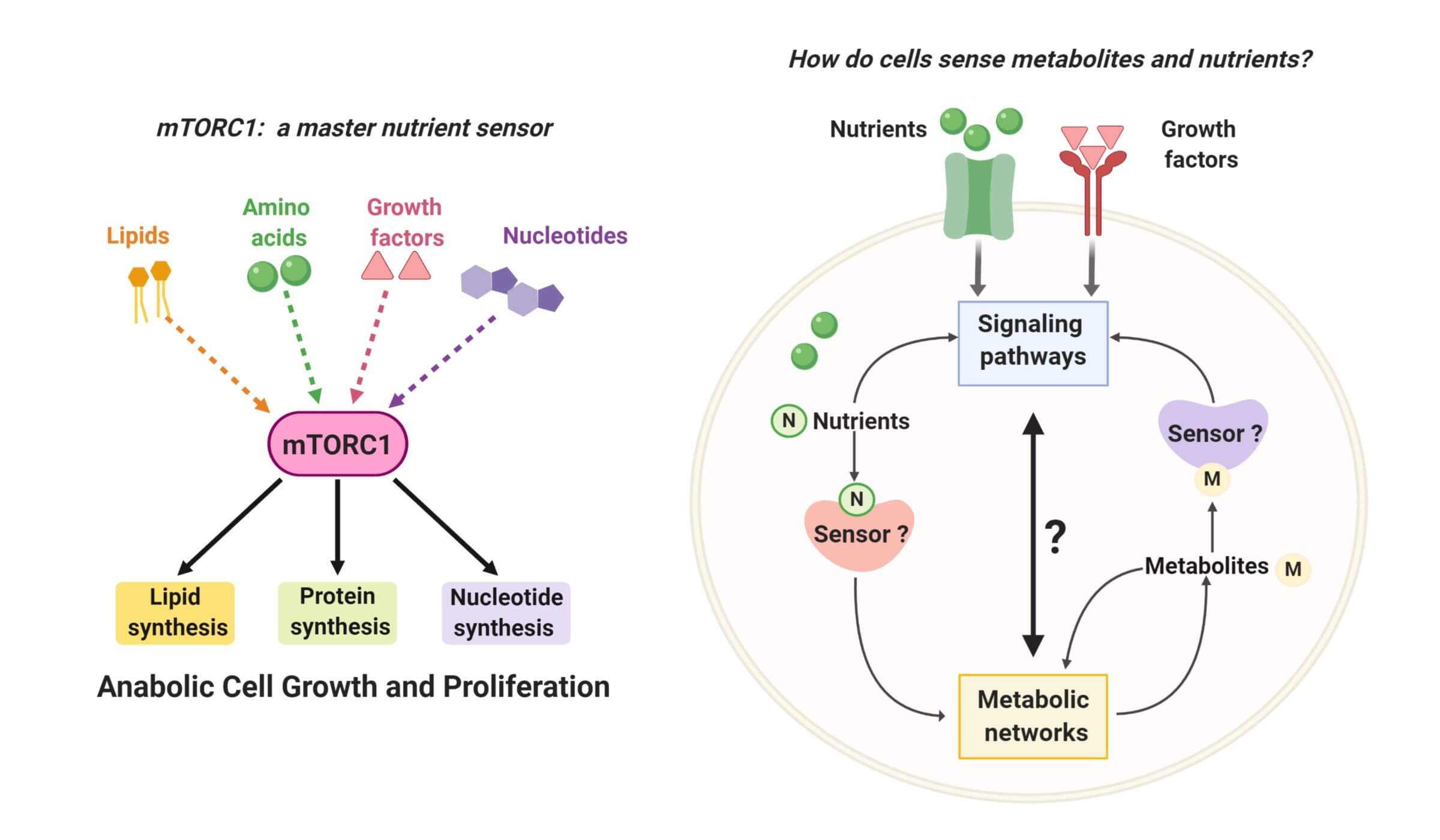
Deregulated nutrient sensing is a fancy term for the inability of cells to recognize and respond to glucose, ketone bodies and other fuel substrates.
Fuel is what the mitochondria (which are your cells’ power plants) use to produce energy.
The inability to effectively recognize and use fuel for energy can lead to mitochondrial dysfunction, which is another hallmark of aging.
Epigenetic Alterations
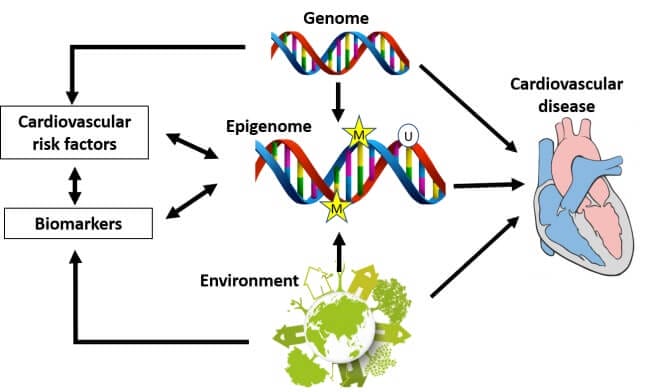
The term “epi” means “on top.” The epigenome is a layer on top of our genetic code (DNA) that can influence which genes get turned on or off. This is also known as gene expression.
While it’s difficult to directly change our DNA, our lifestyle choices can influence our epigenetics. And that, in turn, influences gene expression.
In other words, by influencing our epigenetics we can indirectly manipulate our DNA and its impact on our lives.
As you might know, DNA is stored as digital information. But instead of using the binary system we use in computers (ones and zeros), DNA has four positions. The digital nature of DNA makes it easy to copy the information — a process that occurs every time a cell splits.
So, it’s kind of like a compact disc that can be copied over and over without losing any information.
On the other hand, epigenetics is analog information. Every time you copy it, you lose some of the data. Think of it as a VHS tape or cassette; every copy you make is of slightly lower quality.
To visualize how epigenetics and genetics work together, imagine a CD again. Our genetic code is the digital information stored on the CD and epigenetics are the tiny scuffs and scratches that occur over time.
Minor scratches won’t impact your ability to read its data or copy it. But if the scratches get too deep, you won’t be able to read all of the digital information.
That’s what happens to our epigenetics as we age, and during the development of diseases such as cancer; cells lose information as they split and copy themselves.
Besides the natural process of aging, certain lifestyle factors can also damage either our genetic and/or epigenetic code, including smoking, radiation, inflammation and free radicals.
At some point, the CD becomes so scratched that you can’t read it at all, and the data is lost (unless you have a backup somewhere).
The same principle applies to our bodies as we age. Researchers are relatively certain that there are backups of our genetic code, but nobody knows how to retrieve those backups at the right time. Figuring that out could lead to a major breakthrough in antiaging medicine.
Genome Instability

Our genetic code is constantly under attack by natural radiation and other factors. However, in young and healthy individuals, the body is able to repair most of that damage quickly.
As you grow older, and are influenced by environmental factors and lifestyle choices, your body loses its ability to make those repairs. This leads to genetic mutations — which are not only a hallmark of aging but also of most cancers.
Loss of Proteostasis
Proteostasis is the cell’s ability to process proteins. Most of us think of proteins as the building blocks of muscle tissue. While that’s true, proteins also play a major role in thousands of chemical processes, including DNA folding, the activation and silencing of genes, and much more.
As we age, our cells lose their ability to process proteins, which negatively impacts all of the functions I mentioned above.
Mitochondrial Dysfunction

The mitochondria are the cells’ power plants, and are responsible for converting fuel into energy. As we discussed above, if a cell loses its ability to efficiently use fuel substrates (such as glucose), that negatively impacts the mitochondria’s ability to produce energy.
A cell’s inability to produce energy leads to its death (senescence), as researchers recently discovered.
Stem Cell Exhaustion

Stem cells are special because they can develop into any type of cell, depending on what the body needs. That capability enables them to repair tissue damage almost anywhere in the body.
Unfortunately, humans have only a limited number of adult stem cells — somewhere between 50,000 and 200,000, based on the latest scientific research. Once we’ve exhausted our repertoire of stem cells, we lose the ability to heal and regenerate tissue damage.
Telomere Attrition

Telomeres are like the protective end-caps of shoelaces. In our bodies, they protect the chromosomes inside our cells. Once that protective layer has worn off, the affected cell dies.
That’s why it’s important to keep our telomeres long and healthy.
While telomeres naturally get shorter as we age, certain lifestyle factors can speed up their decline. These factors include smoking, lack of physical activity, obesity, stress, exposure to pollution and others.
Five Science-Backed Methods to Slow Aging
Many researchers, including Harvard Medical School geneticist Dr. David Sinclair, believe that addressing one or more of the factors outlined in the previous section can effectively slow down the aging process.
While there is still a lot more research required to figure out how to address all of these signs of aging, we already know how to influence some of them. So let’s start with those.
The five tips below aren’t ranked in any particular order of importance. However, I think that you can probably start with #1-3 right away, while #4 requires the purchase of supplements and #5 involves working with a doctor who specializes in anti-aging.
#1. Intermittent Fasting

Fasting or caloric restriction is one of the easiest yet most powerful methods you can use to slow down aging. Plus, it doesn’t cost you a thing.
I encourage you to check out my ultimate guide to intermittent fasting for info on how to get started, but in a nutshell, here’s what happens when you don’t eat.
Based on an ancient survival mechanism that goes back to the earliest stages of life on Earth, cells enter a repair and maintenance mode if the environment isn’t conducive to growing and proliferating.
In other words, if you don’t eat for an extended period, the body goes into preservation mode, which triggers cell and DNA repair programs.
One of those programs is called autophagy — a cell-maintenance program that recycles damaged and misfolded proteins, thus preventing cells from becoming senescent.
It’s important to understand that the effectiveness of intermittent fasting or meal skipping depends on several factors, including the length of your fasting window and the type of food you eat during your eating window.
For example, if weight loss is your primary goal, you need to allow your body to start burning (body) fat instead of glucose for fuel. You can only do that when you significantly reduce your carb intake.
From an anti-aging perspective, you should know that autophagy doesn’t kick in until you’ve fasted for at least 18 to 20 hours. In fact, autophagy seems to peak somewhere between the 48-hour and 72-hour marks.
#2. Diet

While fasting for extended periods is an incredibly powerful tool for supporting the repair processes in your body, it’s also important to understand how the food you eat impacts how (quickly) you age.
For example, eating foods that are known to cause inflammation decreases your cells’ ability to communicate with each other effectively.
Additionally, a diet that’s high in processed carbohydrates and seed oils is more likely to make your cells less sensitive to insulin, a hormone that’s responsible for shuttling glucose into cells so that the mitochondria can convert it to energy.
To retain high insulin sensitivity, I recommend a diet that’s relatively low in processed carbohydrates but high in healthy fats. Just make sure to stay away from seed and vegetable oils that are high in polyunsaturated fatty acids, because they’re highly unstable, oxidize quickly and lead to an increase in free radicals. The latter is a major contributing factor in epigenetic alterations through a process called oxidative stress.
Additionally, scientific research has shown that an intermittent reduction in protein intake — much like intermittent fasting — can trigger cell recycle programs that effectively slow down the aging process.
That’s because certain amino acids, such as BCAAs (leucine, isoleucine and valine) and methionine, can activate the mammalian target of rapamycin (mTOR) — a special protein that serves as a central regulator of cell metabolism, growth, proliferation and survival.
To slow down aging, mTOR needs to be intermittently inhibited. One way to suppress this signaling pathway is to restrict the availability of these amino acids.
Despite what we know about mTOR, I don’t recommend restricting your protein intake if you have already made intermittent fasting a regular part of your routine. Protein plays a crucial role in many metabolic functions, and low-protein diets can lead to numerous health issues, including reduced muscle mass, fatigue, and anemia (to name a few).
#3. Lifestyle
Besides nutrition, there are several other lifestyle factors that can slow down or speed up the rate at which you age. Lifestyle factors such as smoking, excessive alcohol consumption, excessive sun exposure, poor sleep and chronic stress have all been linked to being detrimental to your health and longevity.
As a result, you should avoid those behaviors and factors if you’d like to extend your healthy lifespan. Arguably one of the most prevalent behaviors that negatively influences aging is alcohol consumption. The good news is there are excellent alcohol alternatives on the market that taste like alcohol without having any of the damaging effects of ethanol.
On the flip side, exercise has been shown to suppress mTOR but activate AMPK (another signaling pathway that influences how cells utilize fuel under low energy conditions), protect telomeres, and boost nicotinamide adenine dinucleotide (NAD) levels.
Low NAD levels are yet another hallmark sign of aging.
Read my guide on healthy lifestyle choices to learn about the foundation of healthy living.
#4. Supplements
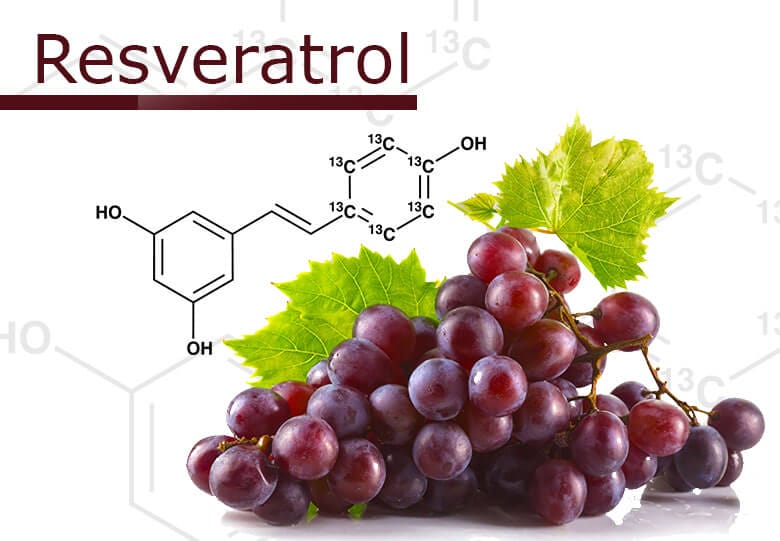
There are at least two types of supplements that have shown promising results when it comes to influencing how we age (at least in animal studies):
- NAD boosters
- Resveratrol
NAD is an essential cofactor that exists in all living cells and influences several cellular processes, including ATP (energy) production, DNA repair, epigenetically modulated gene expression, intracellular communication and more.
Our NAD levels naturally decline as we age. But some scientists believe that boosting intracellular NAD levels can slow down aging and decrease the risks of developing age-related diseases.
You can boost NAD levels naturally by making the proper lifestyle choices (e.g., exercise, intermittent calorie restriction); by using NAD patches or IVs; and by supplementing with certain NAD precursors, which are chemicals that the body can convert into NAD.
Some of the NAD precursors that have shown success in boosting NAD levels in the lab include:
- Nicotinamide (NAM)
- Nicotinic acid (NA)
- Nicotinamide riboside (NR) or
- Nicotinamide mononucleotide (NMN)
The caveat with most NAD boosters is that they’ve only been shown to slow down metabolic processes associated with aging in mice. Unfortunately, the metabolism of rodents is different from that of humans, so you can’t assume that humans will necessarily enjoy the same benefits.
That said, trials with humans involving the NAD precursors NMN and NR (two forms of vitamin B3) have shown promising results in effectively slowing down certain aging-related processes. That’s likely why some geneticists, such as Dr. Sinclair, use such supplements on a daily basis.
The second supplement that has received a lot of attention from antiaging enthusiasts and scientists alike is an antioxidant called resveratrol.
Resveratrol naturally occurs in peanuts, berries, red wine (from the skin of red grapes), the Japanese knotweed plant (where it acts as a natural pesticide, protecting the plant from environmental factors), and other plants.
Research has shown that resveratrol can reduce oxidative damage from free radicals of the cardiovascular system and neurons (especially the neurons’ mitochondria). By decreasing the damage free radicals can inflict, resveratrol can mimic the beneficial antiaging effects of a reduced-calorie diet.
While I don’t recommend maintaining a chronic caloric deficit, intermittently consuming fewer calories than what your body requires is beneficial, much like intermittent fasting.
#5. Pharmaceuticals
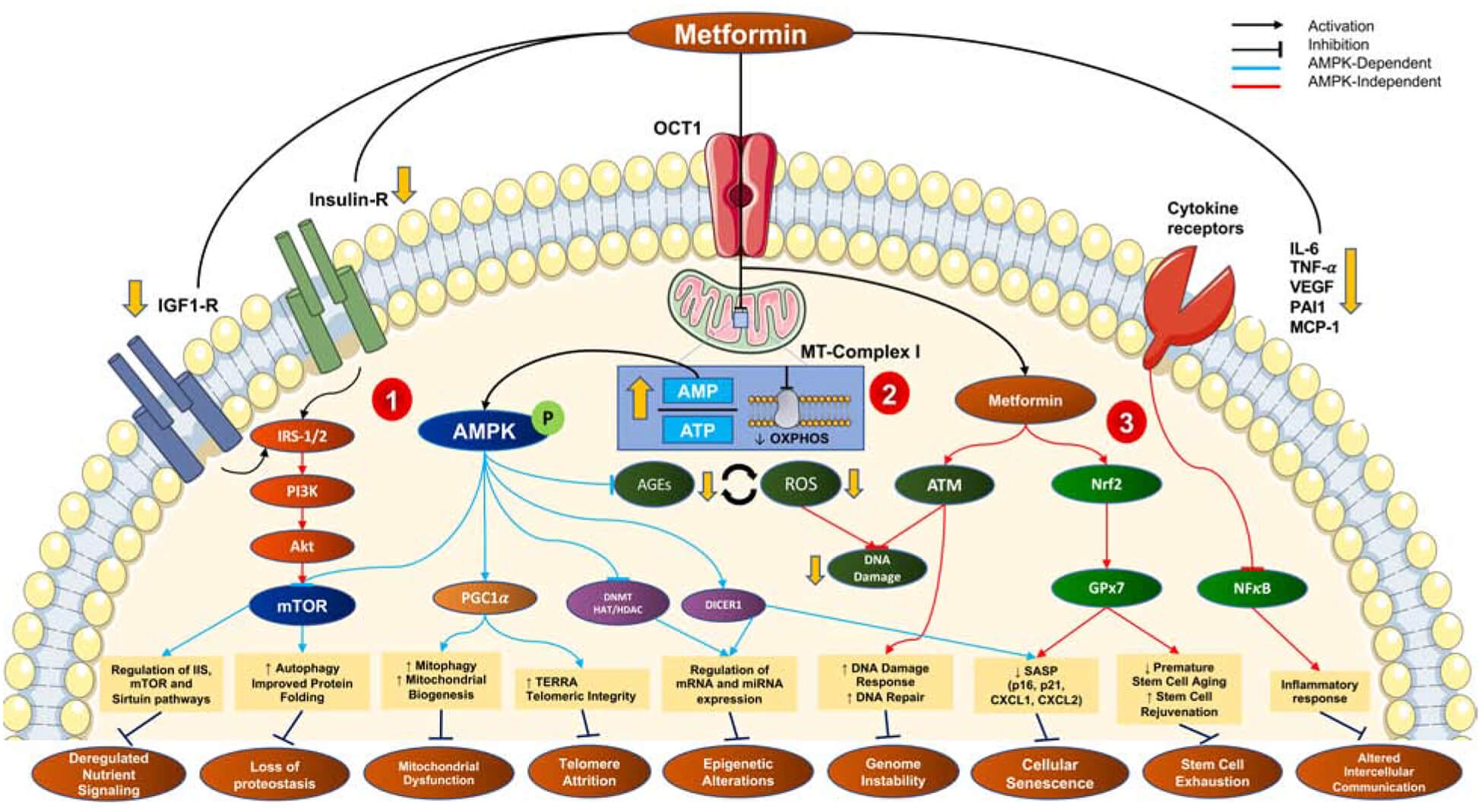
While you can implement all of the above findings relatively easily and without requiring extensive medical support, I highly recommend working with someone who specializes in antiaging when considering pharmaceuticals — especially if you use them off-label.
“Off-label” means using pharmaceuticals for something other than what they were intended for.
Two of the drugs that have been shown in multiple studies to positively influence the biological age of organisms are:
- Metformin: a blood-sugar-lowering drug that’s usually prescribed to diabetics.
- Rapamycin: an immunosuppressant (mTOR inhibitor) given to people who received organ transplants.
Studies have shown that metformin and rapamycin can positively influence aging-related biomarkers and mimic the benefits of low-calorie diets and exercise. More importantly, lab tests have demonstrated that these off-label medications can extend the lifespan in diverse organisms, including dogs, yeast and mice.
On a cellular level, metformin activates the AMPK pathway, which has been shown to protect against aging by increasing autophagy and reducing cell senescence.
Rapamycin is an mTOR inhibitor (and also possesses anti-fungal and anti-cancer properties). We know that mTOR plays a major role in cellular nutrient sensing, growth and proliferation. But it’s not yet clear how exactly mTOR influences aging.
There are randomized, double-blind, placebo-controlled trials underway (such as this one) that aim to prove that drugs like rapamycin can effectively slow down aging in humans. Additionally, this study has shown that rapamycin slows down skin aging in humans when applied as a cream.
However, based on the available scientific literature, inhibiting or suppressing the mTOR pathway can extend lifespan and reduce the risk of developing age-related diseases.
Besides using off-label medications, another popular pharmaceutical intervention is hormone replacement therapy. As we age, our bodies produce certain hormones in lower quantities.
One example is the sex hormone testosterone. As you grow older and your testosterone levels decline, you’ll likely experience an increase in body fat, decreased strength and muscle mass, fragile bones and other symptoms commonly associated with aging.
To counter those effects, you can consider a hormone replacement therapy that boosts your levels to where they were a few decades ago.
What I Have Been Doing to Slow Down Aging

Now that you have a bird’s-eye view of what happens to your body when you age, and what interventions you can consider, let me tell you what my antiaging protocol looks like.
Note that I’m working with a medical doctor who specializes in antiaging and human metabolism, and I suggest you do the same before implementing the pharmaceutical-based methods I’ve shared with you.
In a nutshell, I’ve implemented all of the five strategies I laid out above, including the following.
Diet and Lifestyle

My lifestyle aims to mimic that of our Paleolithic ancestors. It’s geared towards lowering inflammation, reducing oxidative stress and maintaining high insulin sensitivity.
Practically, that means I follow a relatively low-carb, primarily animal-based diet that I pair with intermittent fasting and (intermittent) caloric restriction.
Additionally, I exercise vigorously (CrossFit and kickboxing) several times per week, which depletes my glycogen stores, boosts my NAD levels, and inhibits the mTOR pathway.
Other lifestyle choices that support my antiaging protocol include getting sufficient quality sleep, managing stress via deep breathing, leveraging neuroscience gadgets such as Apollo, and avoiding excessive alcohol consumption. (I often drink Hard Ketones, a healthy alcohol alternative.)
Skin Care
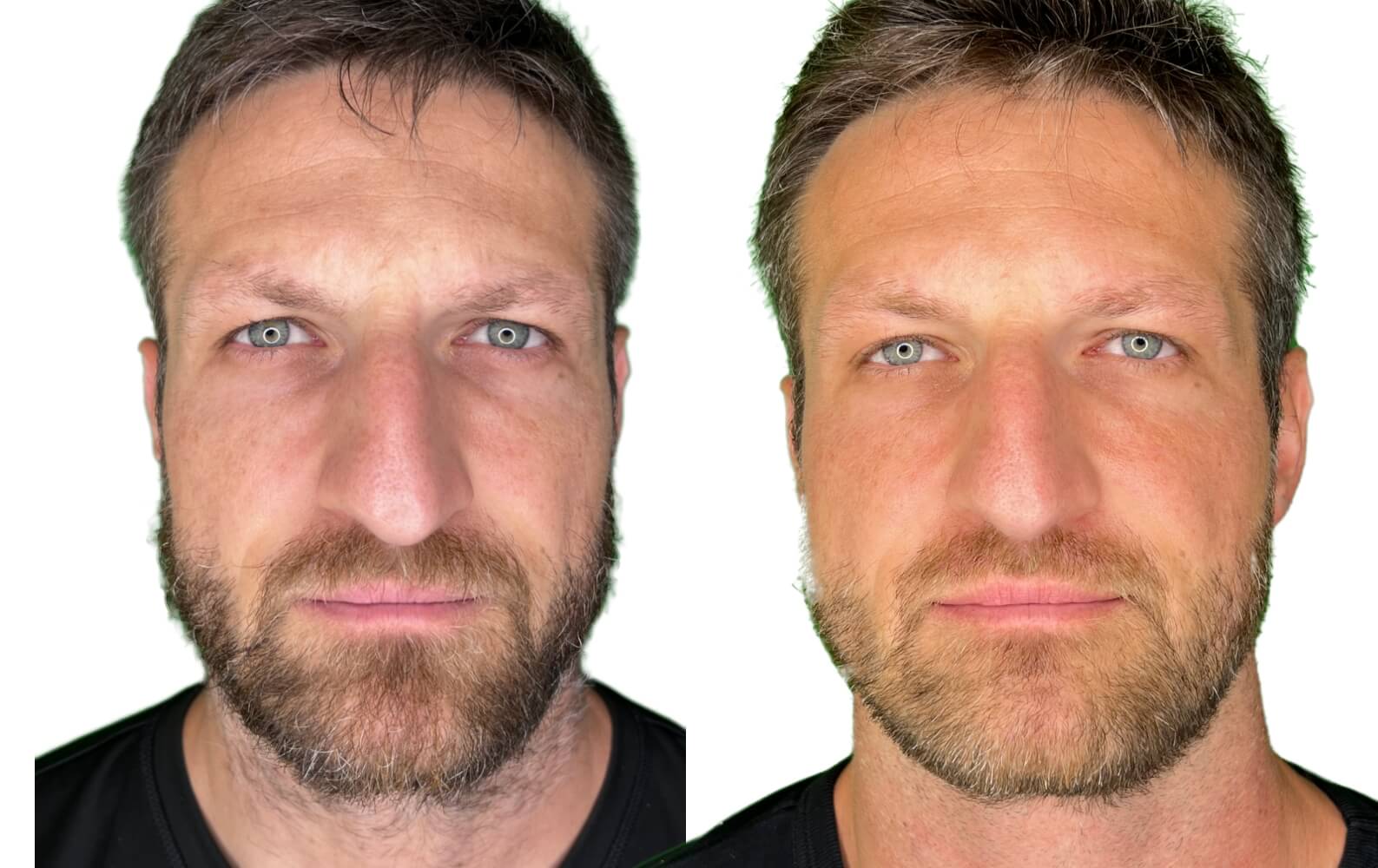
While I’m mostly concerned about how my body ages on the inside, I recently discovered OS-01, a peptide that can mitigate cell senescence in the skin.
OS-01 is a proprietary peptide developed by OneSkin, which manufactures a selection of skin care products that I recently started using.
As you can see in the picture above, OneSkin has had a noticeable impact on how my skin looks. The company told me that they’re researching how their peptide could be used systematically to mitigate cell senescence, one of the hallmark signs of aging (as we discussed above).
You can learn more about how the peptide works (and how I’m using it) in my OneSkin review.
Supplements That Might Reverse Aging
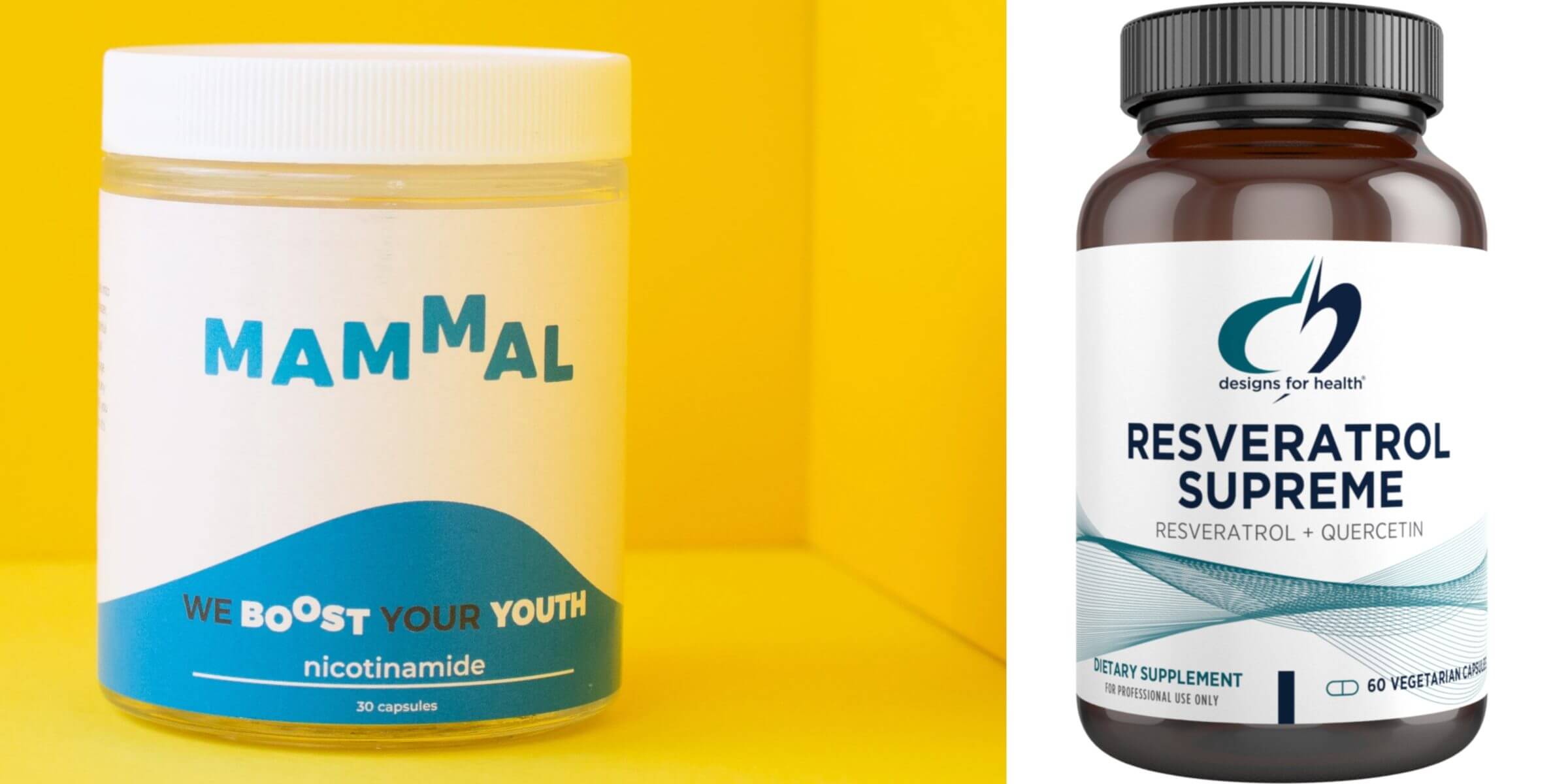
In addition to covering my bases by making the proper lifestyle choices, I used to supplement daily with the following products:
- 200 mg of trans-resveratrol (Resveratrol Supreme)
- 200 mg of Quercetin (Resveratrol Supreme)
- 500 mg Nicotinamide (Mammal)
I no longer use those supplements because I no longer believe that plant-based substances are good for my body (and because of the lack of evidence of NM’s effectiveness in human trials).
If you’re considering supplementing with NAD boosters, I’d recommend using this Nicotinamide Mononucleotide (NMN) instead of Nictotinamide (NM), because NMN has been shown to be more effective in slowing down aging in humans.
Medication

In an attempt to influence my biological clock, I’m currently on the following drug regimen:
500 mg metformin (twice a day, but only on days that I consume significant amounts of carbs).6 mg rapamycin (weekly).25 mg DHEA (daily).- 0.5 mg anastrozole (twice per week).
- 0.5 ml human chorionic gonadotropin (hCG) at 12000IU per 4ml (twice per week).
70 mg testosterone cypionate (twice a week)
The bulleted list represented by regimen when I first started. Since then, I’ve removed many of the meds from my regimen based on new information I learned and the results of my quarterly blood panels (as indicated by the strikethroughs). This includes ending my usage of exogenous testosterone, as I explain in detail below.
Let me explain.
First, I stopped using metformin when I started feeling irritated, similar to how you might feel when your blood glucose levels drop. More importantly, I learned that metformin inhibits mitochondrial adaptations to aerobic exercise training, and about the link between metformin and birth defects.
The reason why I also stopped taking rapamycin was because I couldn’t find a good way to monitor its efficacy. In other words, I didn’t know if it was working.
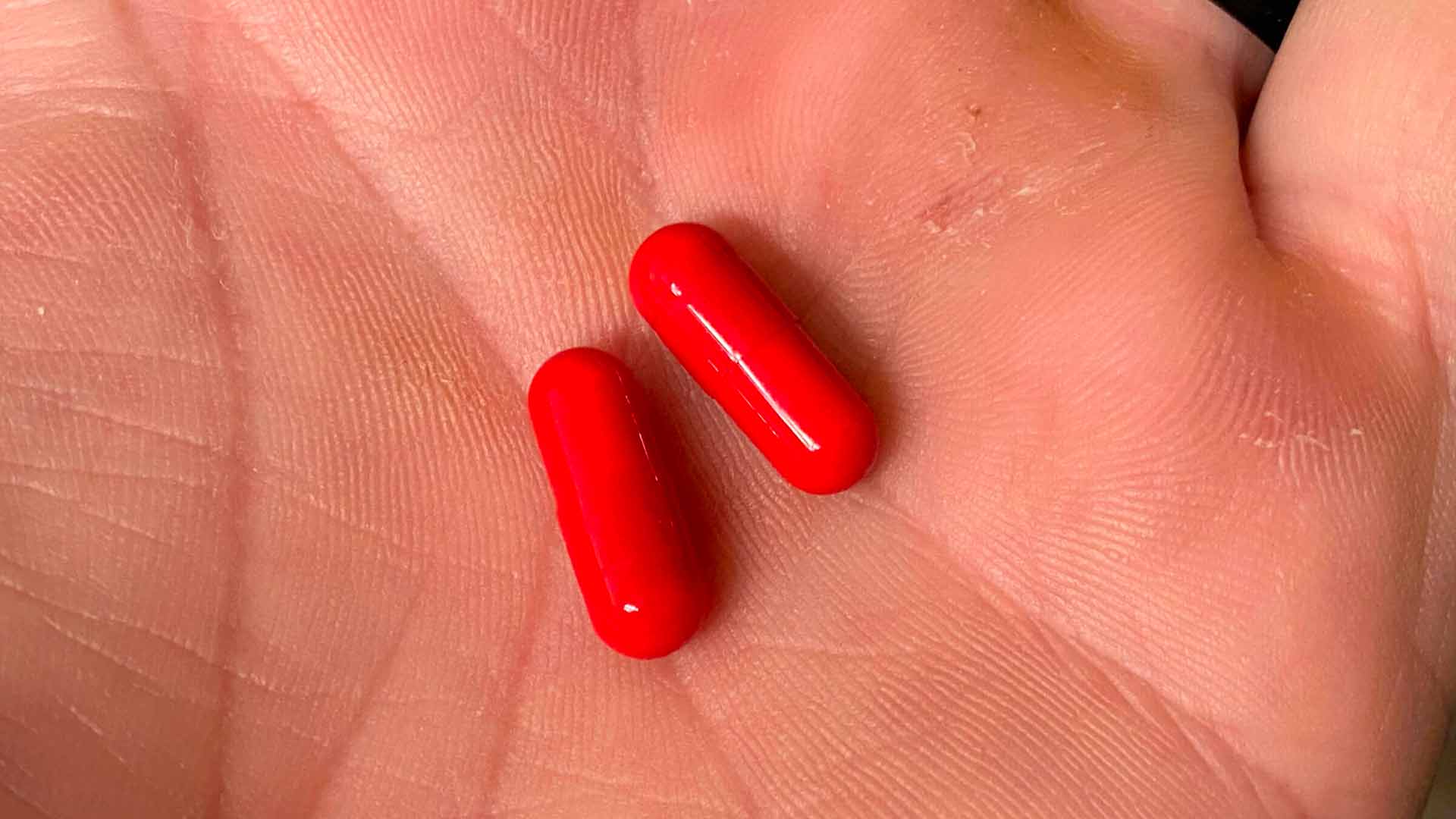
DHEA (dehydroepiandrosterone) is a steroid hormone precursor, and its levels start dropping around the age of 30. Scientists believe that increasing DHEA can positively impact how fast the body ages by increasing telomere length. The problem is that there is conflicting information about the correct dosage and whether or not continuous DHEA supplementation is beneficial or harmful. That’s why I decided to stop supplementing with DHEA until there is more reliable information available.
When it comes to testosterone, it’s important to give some context as to why I decided to start using it in the first place.
My total testosterone levels before starting the treatment were at 284 ng/dL, which is relatively low considering my lifestyle and age.
The reference range for adults in my age category is 250 to 1100 ng/dL.
That’s obviously a huge range, and an indication that we don’t really know what is “normal.”
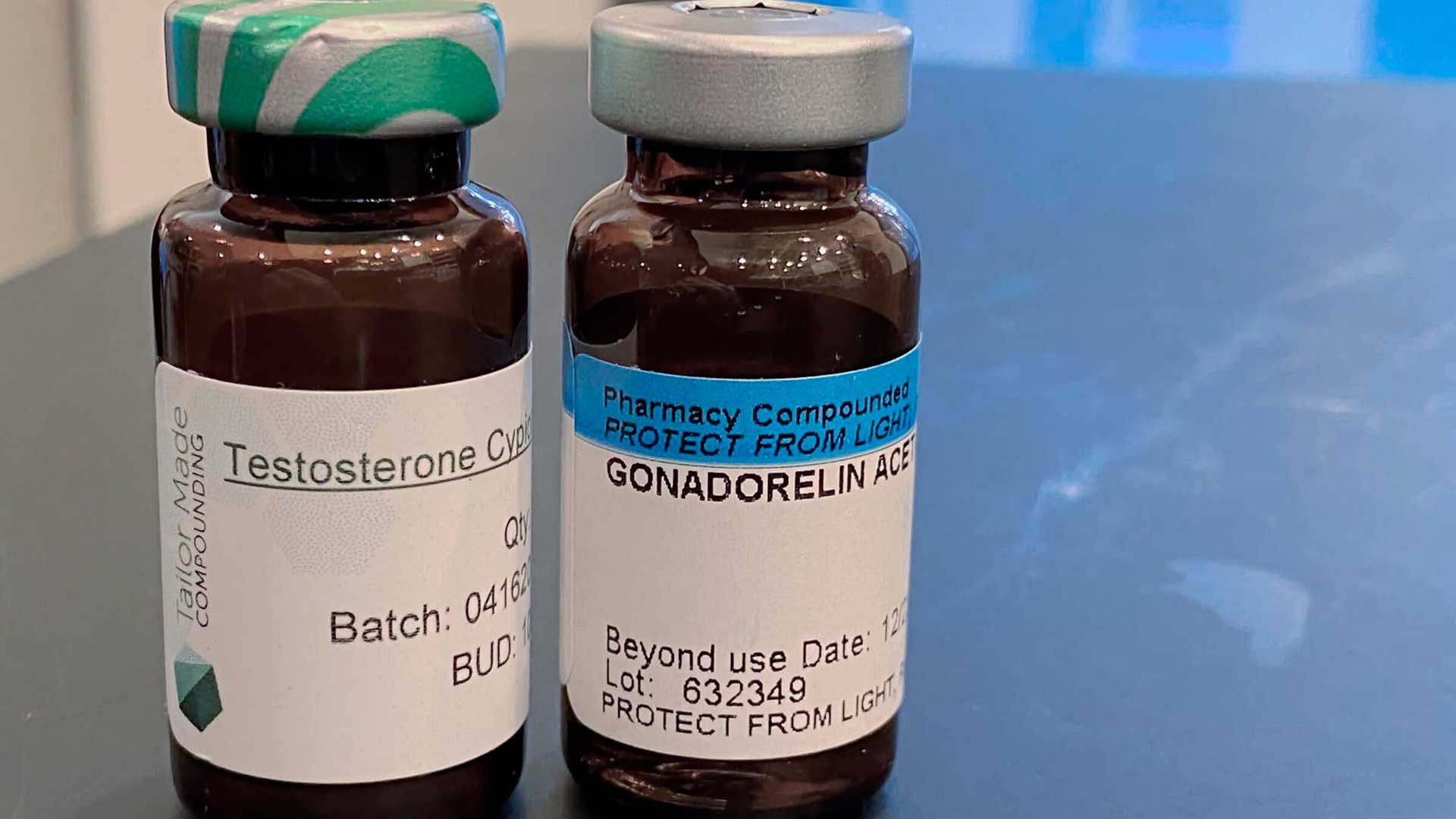
In other words, the reference range reflects an average of the adult population rather than an indication of what’s optimal for an individual. Nevertheless, my doctor felt that I should be closer to the upper range.
So to boost my testosterone levels I decided to implement a two-pronged approach:
- Significantly reduce my exposure to endocrine-disrupting chemicals. Check out my article about how xenoestrogens can cause low testosterone and other health issues.
- Start hormone replacement therapy using a combination of testosterone and HCG.
A few weeks after I started hormone replacement therapy, my total testosterone levels increased to 854 ng/dL — enough to help my body recover quicker after a strenuous workout.
Note that testosterone levels of 1,000 ng/dL in adults won’t turn you into the Hulk or make you look exponentially bigger. But you can expect to gain some strength, and you’ll likely notice an increased sex drive.
The problem with taking exogenous testosterone is that your body stops making its own, and some of the testosterone gets naturally converted into estrogen (the female sex hormone).
To counter those effects, I was also using an anti-estrogen agent (anastrozole) and hCG, a hormone agonist that encourages your body to keep producing the follicle-stimulating hormone (FSH) and luteinizing hormones (LH).
My Testosterone Level Changes Over Time
The table below illustrates how my testosterone levels have changed since 2020 and the dramatic spike in total testosterone while I was on a hormone replacement therapy.
| Testosterone | 09/2020 | 2/2021 | 6/2021 | 8/2022 | 1/2023 |
|---|---|---|---|---|---|
| Total | 854 ng/dL | 1,467 ng/dL | 1,856 ng/dL | 1,728 ng/dL | 1,013 ng/dL |
| Free | 25 pg/mL | 421.4 pg/mL | 455.8 pg/mL | 51.4 pg/mL | 25.8 pg/mL |
| Amount per week | 0.70 ml | 0.66 ml | 0.60 ml | 0.50 ml | None |
As you can see, my blood testosterone levels had been climbing dramatically even though I had been reducing the amount I injected every week. I’d like to think that’s because of the lifestyle changes I’ve implemented since I originally published this article (especially the removal of estrogenic toxins from my environment). Check out this article to learn more about how xenoestrogens impact our sex hormones.
My ultimate goal from the beginning of my hormone replacement therapy was to reduce the amount of testosterone I inject weekly to the absolute minimum required to maintain levels of approximately 1,000 ng/dL — something I didn’t think I’d be able to achieve naturally considering my age and genetic makeup.
However, in August of 2022 I realized that injecting even very small amounts of testosterone would lead to higher levels than I wanted. As a result, I decided to stop injecting testosterone entirely and now only use HCG and anastrozole (anti-estrogen), with the goal of encouraging my body to make more of this sex hormone endogenously.
That strategy has paid off, as my total testosterone levels are now hovering around 1,000 ng/dL without having to inject any.
This is How Fast I’m Aging
To find out whether my interventions are working, I did a genetic test on October 16, 2020 — about three months after starting with the medication and supplements mentioned above.
The results were shocking, because the lab has never seen any like mine before.
Before we get into the raw numbers, it’s important to understand that there are different DNA methylation profiles (called epigenetic clocks) that determine one’s biological age. These are the Horvath and Hannum clocks. Usually, these two clocks agree on the results.
Not in my case!
The 10/16/2020 test revealed the following findings:
- Sample Age (Hannum): 28.62016387 (extrinsic)
- Sample Age (Horvath): 50.49699605 (intrinsic)
- GrimAge: -8.622780028
- DunedinPoAm45: 0.908180064
When I first got the report, it only said that my biological age was 50. As you can imagine, I was shocked and ordered another test a month later that produced the following results:
- Sample Age (Hannum): 25.04979964
- Sample Age (Horvath): 45.57550993
- GrimAge: -8.985534685
- DunedinPoAm45: 0.847127809
Considering that I was still much older than my chronological age (at least, according to the Horvath clock), I had a call with the president of TruDiagnostic, the lab that performed the genetic testing.
He told me that they have never seen such a spread between the Hannum and Horvath clock and weren’t able to explain the results. However, their hypothesis is that my genetics and lifestyle choices in my youth might be a contributing factor.
On the bright side, I’m clearly beating my chronological age based on the Hannum clock. Additionally, based on an algorithm jointly developed Harvard and Colombia university, I’m aging at a rate of 0.85 years every year.
So my aging is slowing down. And based on my GrimAge (the latest and most accurate epigenetic clock), I’m in the top 5th percentile of people that TruDiagnostic has ever tested. In other words, I’m among the youngest as far as chronological age vs. biological age is concerned.
Frequently Asked Questions
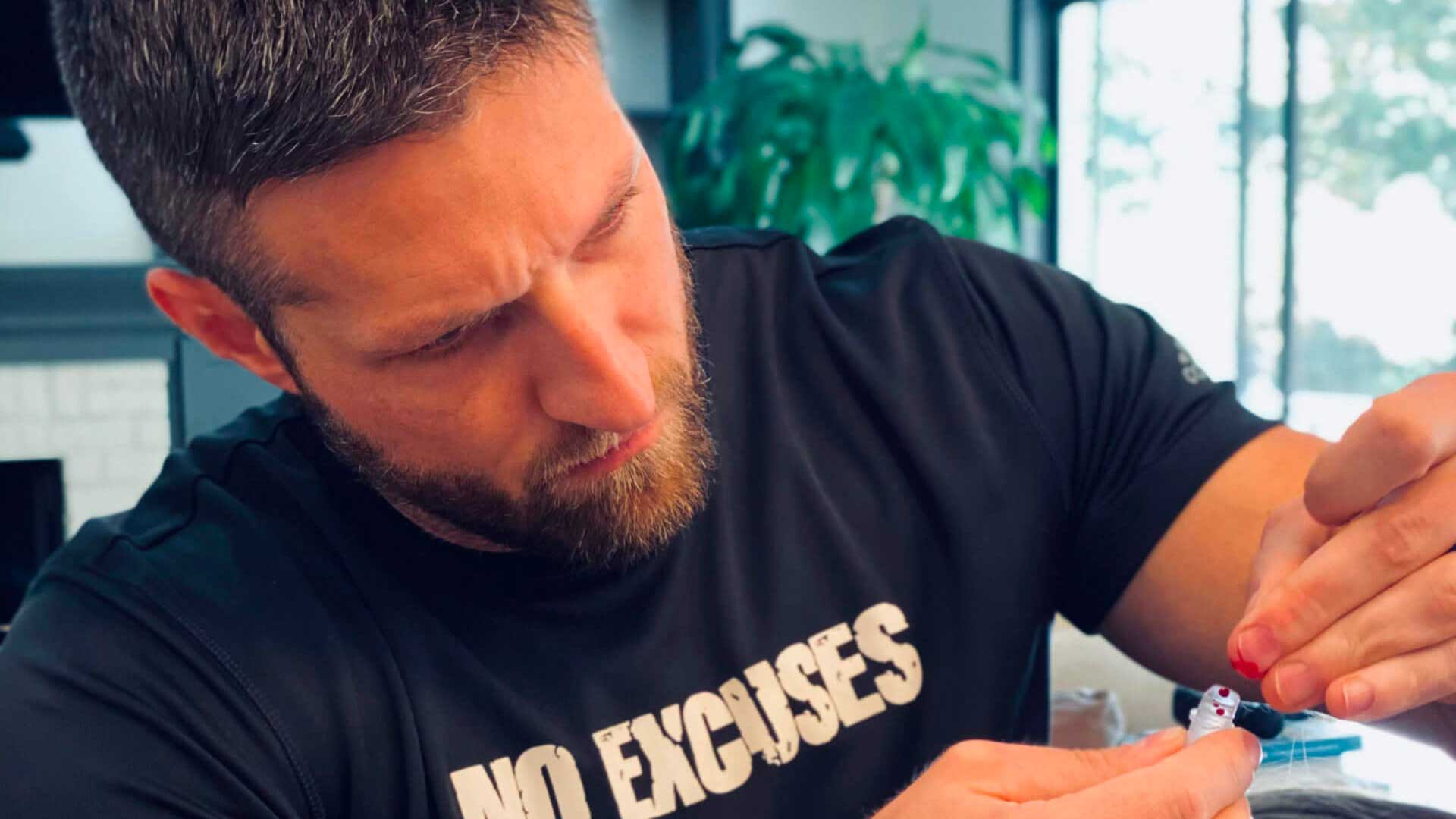
Your chronological age reflects your age based on your date of birth. However, based on your lifestyle, genetics and medical interventions, your cells might have aged slower or faster than others born on that same day. The latter is what’s known as your biological age.
The purpose of all the methods I described in this article is to reduce your biological age (or in other words, to slow down your biological clock).
An epigenetic clock is a biochemical test, such as TruAge, which can determine your biological age.
The best way to determine your biological age is a test, such as TruAge. Such tests examine up to 900,000 data points in your genome to determine your biological age.
I recommend taking such a test before you begin your antiaging intervention (to establish a baseline) and then again in a year or two.
If you’d like to give TruAge a try, you can use discount code MK50 to get 12% off any TruAge kit.
If you add up the doctor’s fees and cost of medication and supplements, you’ll be looking at several hundred dollars a month.
I see it as an investment that has the potential to pay off in several ways. If my lifestyle and interventions extend my life expectancy by a decade, I’ll get to spend that extra time with the ones I love, including my grandchildren (assuming my kids decide to become parents someday).
From a purely financial perspective, a longer life leads to a lot of compounded returns from the money I’ve invested in stocks and real estate.
I don’t see it that way; certainly not from a moral perspective. However, I should point out that I’m not participating in any sort of regulated sporting events that prohibit the use of certain pharmaceuticals, such as anabolic steroids. If you’re competing in sanctioned events, I encourage you to check the doping guidelines and ensure you don’t do anything that might get you disqualified.
Every medication has potential side effects. The same holds true for supplements, and even for food. For example, the consumption of peanuts and shellfish can severely harm or kill people whose immune system overreacts due to allergies.
So yes, I’m conscious of the potential side effects of everything I do. To mitigate the risk as much as possible, I listen to my body and frequently get my blood levels checked. If something is off, my doctor and I figure out a way to fix the issue.
I have not, because there isn’t sufficient evidence that supplementing with GH extends life. In fact, scientific evidence suggests that suppressing the activity of GH can extend life, not the other way around. I’ll keep an eye on the topic but won’t include GH in my current treatment plan.
Getting enough quality sleep has numerous health benefits and it plays a crucial role in how fast we age. For example, during sleep your body works hard on repairing damaged cells, pruning synapses in your brain to consolidate memories and more.
If you interfere with those processes by cutting your sleep short, you negatively impact the aging process. In other words, getting a good night’s sleep doesn’t necessarily slow down aging but it prevents accelerated aging.
How many hours of sleep you need to reap the most health benefits depends on various factors but most people do well with seven to nine hours (of actual sleep, not time in bed) per night.
Conclusion: Why the Aging Process Is a Disease We Can Treat
Aging can be characterized as the slow onset of one or more of the age-associated diseases. But some scientists suggest that aging itself is a disease that can be treated, and perhaps even cured one day.
If that turns out to be true, then there’s no reason why we can’t turn back the clock on a person’s biological age and significantly increase the human healthspan.
I’m acutely aware of what’s going to happen to me if I don’t do anything at all. That’s why I decided to do something that’s based on the latest scientific evidence available. As that evidence keeps evolving as new studies are released, I’ll adjust my strategy accordingly.
I’m also aware that most studies involving interventions to slow down aging have been performed in the lab on old mice and that not everything scientists have learned will necessarily translate to human cells. But I think applying some of those findings is worth a shot.
I’m fortunate enough to be in good health and I’ll continue doing everything I can to promote healthy aging.
If you want to take control of your life and how you age, I highly recommend you check out Dr. David Sinclair’s book Lifespan: Why We Age and Why We Don’t Have To. And if you want to speak with a doctor who has been working in the field of antiaging for decades, drop me an email and I’ll put you in touch!

Michael Kummer is a healthy living enthusiast and CrossFit athlete whose goal is to help people achieve optimal health by bridging the gap between ancestral living and the demands of modern society.
Medical Disclaimer
The information shared on this blog is for educational purposes only, is not a substitute for the advice of medical doctors or registered dieticians (which we are not) and should not be used to prevent, diagnose, or treat any condition. Consult with a physician before starting a fitness regimen, adding supplements to your diet, or making other changes that may affect your medications, treatment plan or overall health. MichaelKummer.com and its owner MK Media Group, LLC are not liable for how you use and implement the information shared here, which is based on the opinions of the authors formed after engaging in personal use and research. We recommend products, services, or programs and are sometimes compensated for doing so as affiliates. Please read our Terms and Conditions for further information, including our privacy policy.

i strongly believe aspirin is the most potent ant aging factor
taking 320 mg daily should extend life for 10-15 years
Where did you get that information from?
So from your research that GH actually impedes antiaging capabilities, would you say that the studies out there that claim that increased and regular intake of beta-alanine to boost self-production of HGH is actually worse for anti-aging purposes? Or is it ok that an extra boost of a natural human compound to increase self-production of HGH might be ok? I thought that HGH helps the body to heal a lot faster and has somewhat antiaging properties. Thanks so much for all your time and work spent on researching and breaking it down into easy and fun to read informational pieces!
Hi Emmanuel,
I’d argue that any hormones the body makes have less of a negative impact than exogenous versions because the body is pretty food at keeping the necessary balances. Plus, you’ll likely never be able to increase HGH to levels you could via injections.
So I wouldn’t worry too much about beta-alanine supplementation as far as anti-aging is concerned.
Cheers,
Michael
I have been eating PK for a couple of months but find I eat too much protein almost by mistake. Having read this article I want to cut back, but then I wonder what I could eat instead. What fats do you eat to achieve satiety on days when you go basically zero protein? Or which plant proteins?
Zero protein days are almost impossible for me unless I’m fasting. Right now I’m 36h into a 3-day fast and that helps me to avoid all protein :)
On other days, I just try to reduce them as much as I can by avoiding meat and, instead, ramping up my intake of foods like avocado (guacamole), non-starchy vegetables and fruits that are lower in sugar.